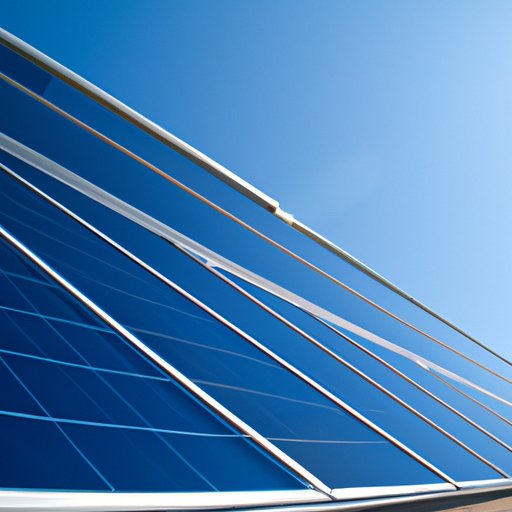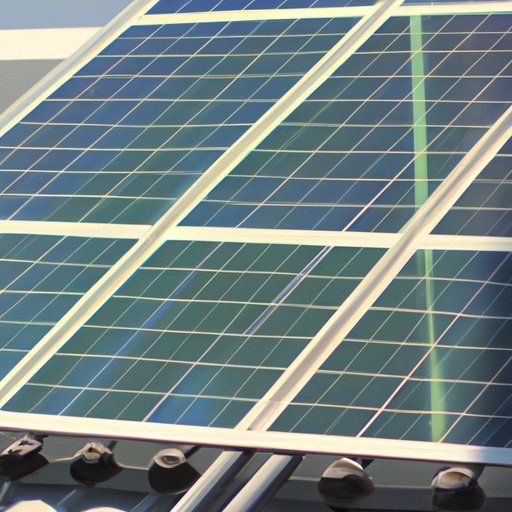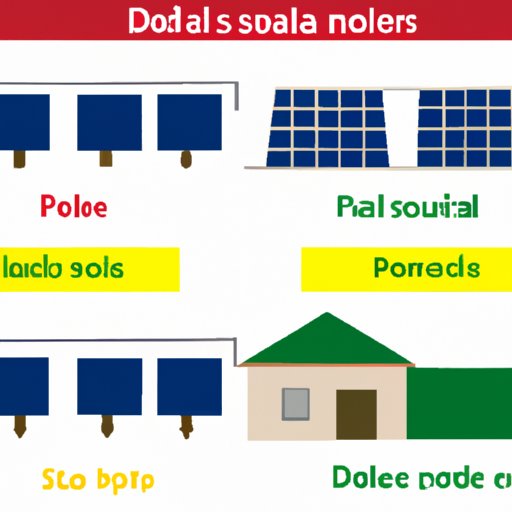
An Overview of the Latest Solar Panel Technology
Solar panels have become increasingly popular in recent years as a way to combat climate change and reduce reliance on fossil fuels. But what exactly is solar panel technology, and what are the advantages and disadvantages? This article will explore the latest developments in solar panel technology and give you the information you need to make an informed decision about whether solar panels are right for you.
Definition of Solar Panels
Solar panels are devices that convert light from the sun into electricity. They consist of a series of photovoltaic cells, which are made of layers of semiconductor material such as silicon. When sunlight hits the cells, it causes electrons to be released, creating an electric current. This current can then be used to power electrical appliances or stored in batteries for later use.
Different Types of Solar Panels
There are three main types of solar panels: monocrystalline, polycrystalline, and thin-film. Monocrystalline solar panels are made from single crystals of silicon and are more efficient than other types of panels. Polycrystalline solar panels are made from multiple crystals of silicon, and they are less efficient but also cheaper. Thin-film solar panels are the least efficient type, but they are also the most affordable.
Advantages and Disadvantages of Solar Panels
The biggest advantage of solar panels is that they are a clean, renewable source of energy. Unlike fossil fuels, they do not produce any air or water pollution. Additionally, they require very little maintenance, and they can last for decades with minimal upkeep. On the downside, solar panels can be expensive to install, and their efficiency can vary depending on the weather and location.

The Benefits of the Newest Solar Panel Technology
The newest solar panel technology offers several benefits compared to older models. Increased efficiency means that more energy can be generated from the same amount of sunlight. Additionally, newer solar panels are often cheaper than older models, making them more accessible to people with limited budgets. Finally, the latest solar panel technology has significant environmental benefits, as it produces no air or water pollution.
Increased Efficiency
Recent advances in solar panel technology have resulted in increased efficiency. According to a study by the National Renewable Energy Laboratory, “the average efficiency of commercialized photovoltaic cells has increased from 14% to 21% over the past decade.” This means that more energy can be generated from the same amount of sunlight, allowing homeowners to generate more power and save money on their energy bills.
Cost Savings
Newer solar panels are often cheaper than older models, making them more accessible to those with limited budgets. According to the U.S. Department of Energy, “the cost of solar panels has been falling steadily since the late 1990s, and is now around one-third of what it was then.” This makes solar panels a much more attractive option for people looking to reduce their energy costs.
Environmental Benefits
The newest solar panel technology has significant environmental benefits. Solar panels produce no air or water pollution, and they can help reduce our dependence on fossil fuels. According to the International Energy Agency, “solar energy could provide up to 16% of global electricity demand by 2050, reducing emissions by up to 6 gigatons of carbon dioxide per year.” This could have a huge impact on our environment and help us move towards a cleaner, more sustainable future.
An In-Depth Look at the Latest Solar Panels
Now that we’ve explored the benefits of the newest solar panel technology, let’s take a closer look at the different types of solar panels available. There are three main types: monocrystalline, polycrystalline, and thin-film.
Monocrystalline Solar Panels
Monocrystalline solar panels are made from single crystals of silicon and are the most efficient type of solar panel. They are also the most expensive, but they require less space to generate the same amount of energy as other types of panels. Monocrystalline solar panels are a good choice if you have limited space but still want to generate a lot of power.
Polycrystalline Solar Panels
Polycrystalline solar panels are made from multiple crystals of silicon, and they are less efficient but also cheaper. They are a good option for people who want to save money but still generate a significant amount of power. They require more space to generate the same amount of energy as monocrystalline panels, but they are still a good choice for many people.
Thin-Film Solar Panels
Thin-film solar panels are the least efficient type, but they are also the most affordable. They are a good choice for people who want to save money and don’t need a lot of power. However, they require a lot of space to generate the same amount of energy as monocrystalline or polycrystalline panels.
How to Choose the Right Solar Panel Technology
Choosing the right solar panel technology can be daunting, but there are a few factors to consider when making your decision. First, consider your location and the amount of sunlight you receive. Different types of solar panels are more efficient in different climates, so it’s important to choose the right type for your area. Next, evaluate your energy needs. If you need a lot of power, monocrystalline panels may be the best option. Finally, research government incentives. Many states offer incentives for installing solar panels, which can help offset the cost.

A Comparison of the Different Types of Solar Panel Technologies
When considering which type of solar panel technology is right for you, it’s important to compare the different types. Here is a comparison of monocrystalline vs. polycrystalline, monocrystalline vs. thin-film, and polycrystalline vs. thin-film.
Monocrystalline vs. Polycrystalline
Monocrystalline solar panels are more efficient than polycrystalline panels, but they are also more expensive. Monocrystalline panels are a better choice if you have limited space but still need a lot of power. Polycrystalline panels are a better choice if you need less power and are looking to save money.
Monocrystalline vs. Thin-Film
Monocrystalline solar panels are more efficient than thin-film panels, but they are also more expensive. Monocrystalline panels are a good choice if you need a lot of power and don’t have a lot of space. Thin-film panels are a good choice if you need less power and are looking to save money.
Polycrystalline vs. Thin-Film
Polycrystalline solar panels are more efficient than thin-film panels, but they are also more expensive. Polycrystalline panels are a good choice if you need a lot of power and don’t have a lot of space. Thin-film panels are a good choice if you need less power and are looking to save money.
Exploring the Future of Solar Panel Technology
The future of solar panel technology holds exciting possibilities. Advances in technology are making solar panels more efficient and cost-effective. Additionally, there is growing interest in integrating solar energy with other renewable sources such as wind and hydropower. Finally, the increasing popularity of solar panels is having a positive impact on the environment, as it reduces our reliance on fossil fuels.
Advances in Technology
Researchers are constantly working to improve the efficiency and cost-effectiveness of solar panels. Recent advancements include the development of transparent solar cells, which can be used to generate electricity from windows and other surfaces. Additionally, researchers are developing new materials that can be used to create thinner and more efficient solar panels.
Integration with Other Renewable Sources
Many experts believe that solar energy should be integrated with other renewable sources such as wind and hydropower. This would allow us to generate more energy while reducing our reliance on fossil fuels. For example, a hybrid system combining solar and wind energy could provide a reliable source of electricity even during times when the sun is not shining or the wind is not blowing.
Implications for the Environment
The increasing popularity of solar panels is having a positive impact on the environment. According to a report by the International Renewable Energy Agency, “global installed capacity of solar photovoltaics is expected to grow from approximately 400 GW in 2019 to 2,000 GW by 2030.” This could reduce global greenhouse gas emissions by up to 3 gigatons of carbon dioxide per year.
Conclusion
Solar panel technology has come a long way in recent years, and the newest models offer increased efficiency and cost savings. There are three main types of solar panels: monocrystalline, polycrystalline, and thin-film. When choosing the right type of solar panel for your needs, consider your location and energy needs, and research government incentives. The future of solar panel technology holds exciting possibilities, and it has the potential to have a huge impact on our environment.
(Note: Is this article not meeting your expectations? Do you have knowledge or insights to share? Unlock new opportunities and expand your reach by joining our authors team. Click Registration to join us and share your expertise with our readers.)
